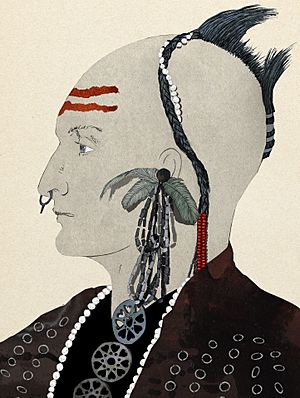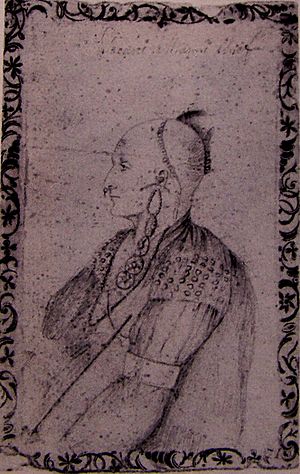Pacanne facts for kids
Quick facts for kids
Pacanne
|
|
|---|---|
| P'Koum-Kwa | |

Chief Pacan. Image provided by Valencian Museum of Ethnology
|
|
| Miami leader | |
| Succeeded by | Jean Baptiste Richardville |
| Personal details | |
| Born | 1737 |
| Died | 1816 (aged 78–79) |
| Relations | Tacumwah |

Pacanne (born around 1737, died 1816) was an important Miami chief. He was a leader during the late 1700s and early 1800s. His father was named The Turtle (Aquenackqua).
Pacanne was also the brother of Tacumwah. She was the mother of Chief Jean Baptiste Richardville. Their family was very powerful. They owned a special piece of land called the Long Portage. This was an 8-mile strip of land between the Maumee and Wabash Rivers. Traders used it to travel between Canada and Louisiana. Because of this, Pacanne's family was one of the most influential in Kekionga.
Contents
Pacanne's Early Life and Leadership
Pacanne, whose native name was P'Koum-Kwa, was likely the nephew of Cold Foot. Cold Foot was the Miami Chief of Kekionga until he died from an illness in 1752.
One of the first times Pacanne is mentioned is in 1764. A British officer named Captain Thomas Morris was sent to secure several villages. These included Kekionga, Ouiatenon, Vincennes, and Kaskaskia. This happened after a conflict known as Pontiac's Rebellion.
At Fort Miamis, near Kekionga, two Miami warriors captured Morris. They tied him to a pole and planned to harm him. According to Morris's report, Pacanne, who was still young, rode up and set him free. This event might have been a way to show that Pacanne was becoming a leader.
Traveling and Managing Kekionga
As a chief and a businessman, Pacanne traveled a lot. He visited villages far away, like Vincennes, Fort Detroit, Quebec City, and Fort Niagara.
When Pacanne was away, his sister Tacumwah and her son managed Kekionga. Other nearby chiefs, Little Turtle and Le Gris, also helped. Because Pacanne was often gone, some people mistakenly thought Le Gris was a higher-ranking chief.
Pacanne and Major Conflicts
Pacanne played a part in several important wars. He often had to choose sides between the British and the Americans.
Role in the American Revolution
In the autumn of 1778, during the American Revolution, Pacanne joined British Lt-Governor Henry Hamilton. They traveled down the Wabash River to take back Vincennes.
While there, Pacanne spoke to the Piankeshaw chiefs, Young Tobacco and Old Tobacco. These chiefs had supported the Americans. Pacanne told them to listen carefully to Hamilton.
After a raid on Kekionga in November 1780, Pacanne openly supported the British. This raid was carried out by a French colonial militia. Pacanne said, "You see our village stained with blood... if we find you with them that we will not make any distinction."
The Miami of Kekionga asked for help to attack Vincennes. However, the British aid never arrived, so the attack did not happen. The British commander, Arent DePeyster, praised Pacanne's loyalty. He said they thought the same way about the war.
After the American Revolution
After the American Revolution, Pacanne worked as a go-between. He helped the new United States and the Miami Confederacy communicate. He guided Colonel Josiah Harmar and worked with Major Jean François Hamtramck.
However, in August 1788, a group of men from Kentucky attacked a Piankeshaw village near Vincennes. They got away. Major Hamtramck promised to punish them but could not. When Pacanne returned to Vincennes and heard about the attack, he stopped talking to Hamtramck. He went back to Kekionga.
The Northwest Indian War
The next few years saw many big battles between the United States Army and Native American nations. This period is known as the Northwest Indian War. Kekionga was a base for many raids against American settlers.
Because of this, American forces targeted Kekionga. This led to several battles, including Hardin's Defeat, Harmar's Defeat, and St. Clair's Defeat.
These conflicts ended with the Battle of Fallen Timbers and the Treaty of Greenville in 1795. Miami war chief Little Turtle signed the treaty for the Miami people. But Pacanne did not attend; he sent his nephew, Chief Richardville, instead. Pacanne still refused to sign the treaty later.
Even so, the chiefs encouraged everyone to follow the treaty. They opposed younger leaders, like Tecumseh, who continued to fight against the Americans. Pacanne moved to a village near the Mississinewa River, close to what is now Peru, Indiana.
The War of 1812
Pacanne actively tried to have better relations with the United States. He stayed neutral at the start of the War of 1812. But after the Americans reacted to the Fort Dearborn Massacre, Pacanne again sided with the British.
Pacanne's Legacy
Pacanne died in 1816. His nephew, Jean Baptiste Richardville, became chief after him.

